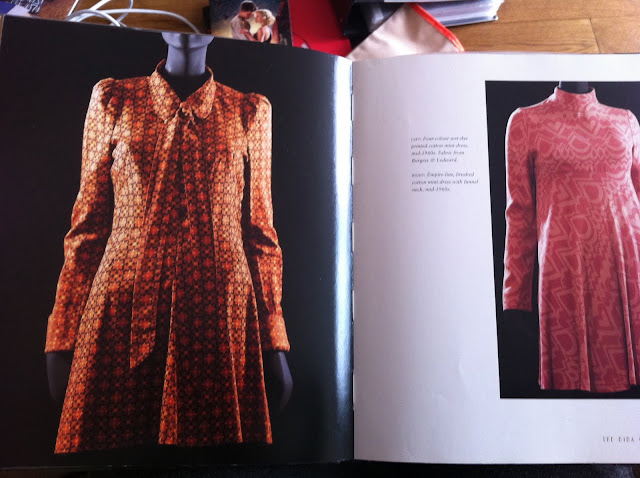So I've been working on my CAD work for Gemma over the Christmas Holidays and heres what I've come up with so far...
I scanned in some of the embellishment from the actual garment so I could get the right effect on the technical drawing, this made it easier for me to concentrate on the more structured part of the design.
CAD is not one of my strengths but I tried my best to portray gathering on the bodice as best as I could using shading and gradient tools on Adobe illustrator.








 iba is frequently mentioned in the same giddy breath as mini-skirts, Mini cars, the Kings Road, the pill and various other London 'happenings' which shall forever define the 1960's as a decade that swung. It was, however, born of humble origins - garments were initially sold cheaply and to many, by mail order in newspapers. But by the early 1970's, Biba - a labour of love, a label, a lifestyle - had reached hitherto unknown heights of sophistication, innovation and retail experimentation, via its legendary Big Biba emporium on Kensington High Street (once hailed in the Sunday Times as 'the most beautiful store in the world'). Biba makes for a true rags to riches story, though one devoid of a happy ending for its creators... fashion can be a very cruel beast.
iba is frequently mentioned in the same giddy breath as mini-skirts, Mini cars, the Kings Road, the pill and various other London 'happenings' which shall forever define the 1960's as a decade that swung. It was, however, born of humble origins - garments were initially sold cheaply and to many, by mail order in newspapers. But by the early 1970's, Biba - a labour of love, a label, a lifestyle - had reached hitherto unknown heights of sophistication, innovation and retail experimentation, via its legendary Big Biba emporium on Kensington High Street (once hailed in the Sunday Times as 'the most beautiful store in the world'). Biba makes for a true rags to riches story, though one devoid of a happy ending for its creators... fashion can be a very cruel beast. et Hulanicki felt that Biba could become an even bigger phenomena still. She obsessed over the 400,000 square foot, Art Deco Derry and Tom's department store on Kensington High Street. It had long since faded from glory, but was still complete with its romantic rooftop garden (today, this is still in existence and utilised for dining, private parties and promotional events, such as album launches). Following many complex financial twists, turns and near misses, and with the involvement of the Fraser group and Dorothy Perkins, they secured the building for £3.9 million. Literally hundreds of builders duly prepared the space - working to a budget of £1 million - and toiling around the clock for months on end. The former Biba store can, in hindsight, be seen as a dress rehearsal for this ultra-bold venture: Big Biba - the first new department store in the Capital since the second world war. Though it was not so much a mere department store as a kind of spectacular fantasy-land shopping/eating/drinking/hanging out/rooftop garden-perching experience. One entire floor was named the Casbah - filled with Moroccan and Turkish-influenced splendour; there was a Biba food hall; anyone could sit in the windows - traditional displays were banished (which would be deemed commercial suicide in this day and age); penguins and pink flamingos lived on the roof; the Rainbow Room restaurant and concert hall - with its pink marbled floors - served 1,500 meals a day on exquisite black china. Performers whom appeared there ranged from the New York Dolls to The Wombles, from Liberace to The Bay City Rollers, with artist Andrew Logan hosting oppulent fancy dress parties, still talked about to this day.
et Hulanicki felt that Biba could become an even bigger phenomena still. She obsessed over the 400,000 square foot, Art Deco Derry and Tom's department store on Kensington High Street. It had long since faded from glory, but was still complete with its romantic rooftop garden (today, this is still in existence and utilised for dining, private parties and promotional events, such as album launches). Following many complex financial twists, turns and near misses, and with the involvement of the Fraser group and Dorothy Perkins, they secured the building for £3.9 million. Literally hundreds of builders duly prepared the space - working to a budget of £1 million - and toiling around the clock for months on end. The former Biba store can, in hindsight, be seen as a dress rehearsal for this ultra-bold venture: Big Biba - the first new department store in the Capital since the second world war. Though it was not so much a mere department store as a kind of spectacular fantasy-land shopping/eating/drinking/hanging out/rooftop garden-perching experience. One entire floor was named the Casbah - filled with Moroccan and Turkish-influenced splendour; there was a Biba food hall; anyone could sit in the windows - traditional displays were banished (which would be deemed commercial suicide in this day and age); penguins and pink flamingos lived on the roof; the Rainbow Room restaurant and concert hall - with its pink marbled floors - served 1,500 meals a day on exquisite black china. Performers whom appeared there ranged from the New York Dolls to The Wombles, from Liberace to The Bay City Rollers, with artist Andrew Logan hosting oppulent fancy dress parties, still talked about to this day.











